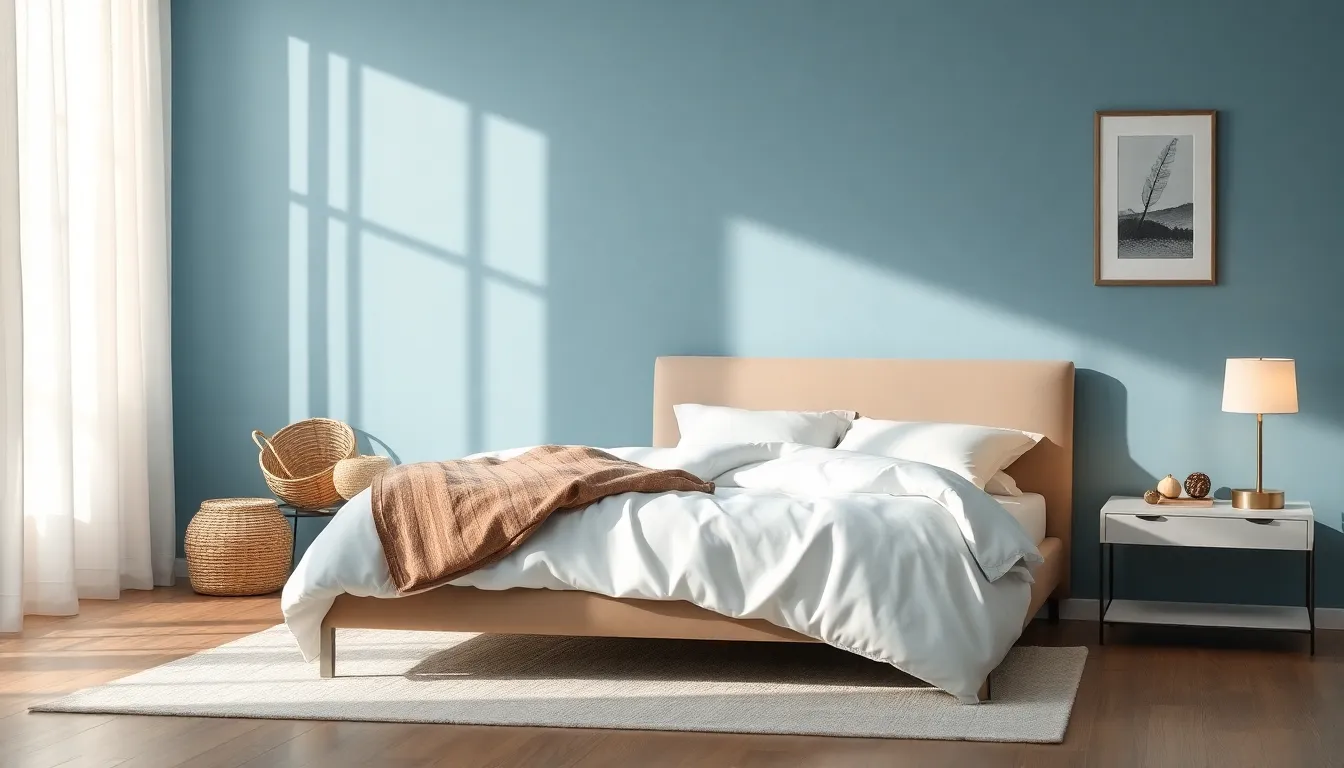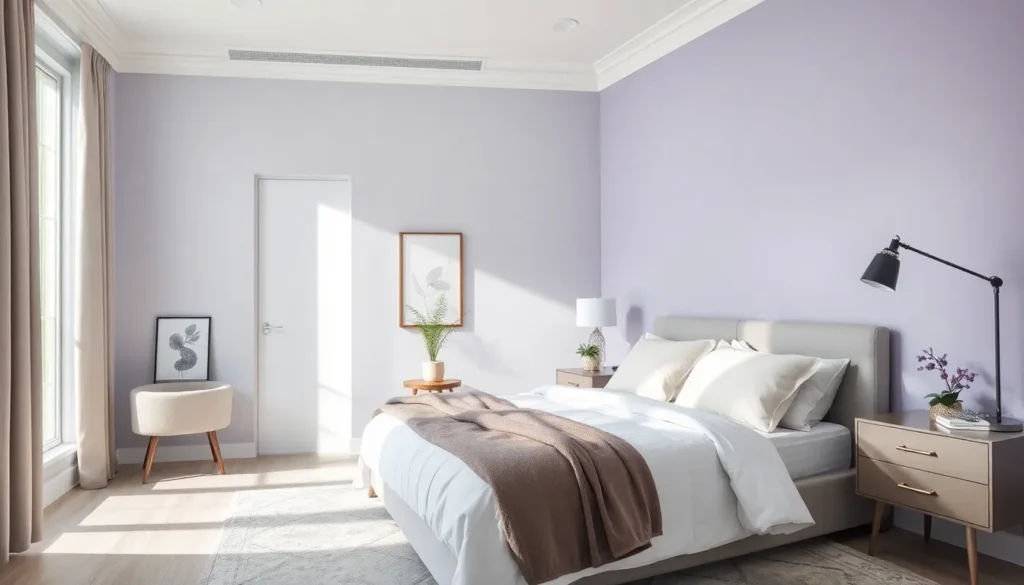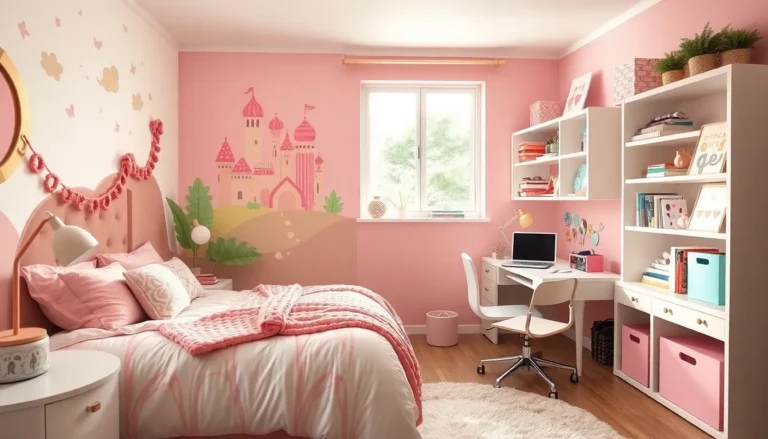Choosing paint for bedrooms is more than just picking a pretty color: it’s an art form. The right shade can transform a mundane space into a dreamy retreat. But, with so many options available, the task can feel as daunting as solving a Rubik’s Cube while blindfolded. Fear not. This guide will navigate through paint colors, trends, eco-friendly options, and application techniques, ensuring that your bedroom not only looks good but feels good too. So grab your brushes and let’s get started.
Table of Contents
ToggleImportance Of Choosing The Right Paint Color

The bedroom is often seen as a sanctuary, a place for rest and rejuvenation. Hence, the importance of choosing the right paint color cannot be overstated.
Psychological Effects Of Colors
Color psychology plays a crucial role in how spaces make us feel. For instance, shades of blue tend to evoke a sense of calm and tranquility, perfect for those winding down at the end of a long day. On the other hand, vibrant colors like yellow can inject energy into a space, though they might not be the best choice for a restful environment. Understanding these psychological effects will help in creating the ideal atmosphere for relaxation and sleep.
Creating A Relaxing Atmosphere
A soothing bedroom requires careful consideration of paint choices. Earthy tones, such as soft greens and sandy beiges, can create a cocoon-like feel, encouraging relaxation. A room bathed in pale colors reflects light beautifully, making it feel more spacious. In contrast, darker colors can add intimacy to the space. So, picking the right hue can make all the difference in establishing a bedroom atmosphere that is both welcoming and serene.
Trends In Bedroom Paint Colors
Keeping up with trends can be as exhilarating as riding a roller coaster. When it comes to bedroom paint colors, several palettes shine brightly among homeowners and designers alike.
Popular Color Palettes For Bedrooms
Currently, soft pastels are very much in vogue. Colors like lavender, powder blue, and mint green present a soft touch that is aesthetically pleasing and versatile. They allow for a variety of decor styles, from modern to classic. Plus, darker shades like navy and charcoal can provide a stunning contrast, adding depth to the overall design.
Classic Neutrals
You can never go wrong with classic neutrals. Whites, grays, and beiges serve as a blank canvas, which can be dressed up with colorful decor and plants. These colors are timeless and can create a space that feels both fresh and sophisticated, perfect for any age group. It’s a safe bet that can complement both the latest trends and enduring styles.
Bold Accents
For those who yearn for a splash of creativity, bold accent colors can enhance any neutral room. Imagine a deep emerald green accent wall paired with beige or white: this contrast can invigorate the room’s design. Accent colors are like spices for your paint palette, when used carefully, they can add a burst of flavor without overwhelming the space.
Eco-Friendly Paint Options
With increasing awareness of environmental health, eco-friendly paint options are becoming more sought after. Homeowners are looking for ways to maintain their bedroom sanctuaries while also being kind to the planet.
Types Of Eco-Friendly Paints
There are many types of eco-friendly paints available today, including low-VOC (Volatile Organic Compounds), zero-VOC, and organic paints. These formulations emit fewer harmful chemicals than traditional paints, reducing indoor air pollution. Also, brands are emerging that offer paint made from natural ingredients, which is beneficial for both human health and the environment.
Benefits Of Using Non-Toxic Paints
Using non-toxic paints not only fosters a healthier living space but also assures peace of mind for families. Children and pets are often more prone to the adverse effects of chemical exposures. Choosing eco-friendly options mitigates these risks significantly. Also, these paints tend to offer rich, lasting colors that stand up against traditional formulations. It’s a win-win situation.
Tips For Selecting Paint Finishes
Choosing the right paint finish is just as crucial as picking the color itself. Different finishes serve different purposes and can completely change the vibe of a room.
Matte Vs. Satin Finishes
Matte finishes are fantastic for hiding imperfections and creating a soft, cozy look. They absorb light, giving a subtle appearance, especially in bedrooms where a tranquil ambiance is key. Conversely, satin finishes offer a bit of sheen, making them easier to clean and more durable, particularly in high-traffic areas. The choice between the two really depends on lifestyle needs and desired aesthetics.
Durability And Maintenance Considerations
Paint finishes are not one-size-fits-all. While matte finishes require gentle cleaning methods, satin finishes can withstand scrubbing. Knowing the durability of the paint will help in maintaining its appearance over time. Hence, it’s wise to think about the size and usage of the space before making a final decision.
Preparation And Application Tips
Before diving into painting, a bit of preparation can go a long way. Here are some pro tips.
Surface Preparation Techniques
Ensuring a clean and smooth surface is essential for achieving that professional finish. Surface cleaning should be your first step. Dust, grease, and any peeling paint need to be dealt with before applying any new paint. Filling in holes and sanding rough areas can also enhance paint adhesion and smoothness, the happier your surface, the happier your paint will be.
Best Practices For Application
When it comes to application, patience is your best friend. Using quality brushes and rollers designed for the finish is key to achieving a seamless look. Start by cutting in around edges before rolling the walls, and remember that a second coat often makes a world of difference in color vibrancy and uniformity. It’s all about taking your time and not rushing the process. Quality work speaks volumes.



